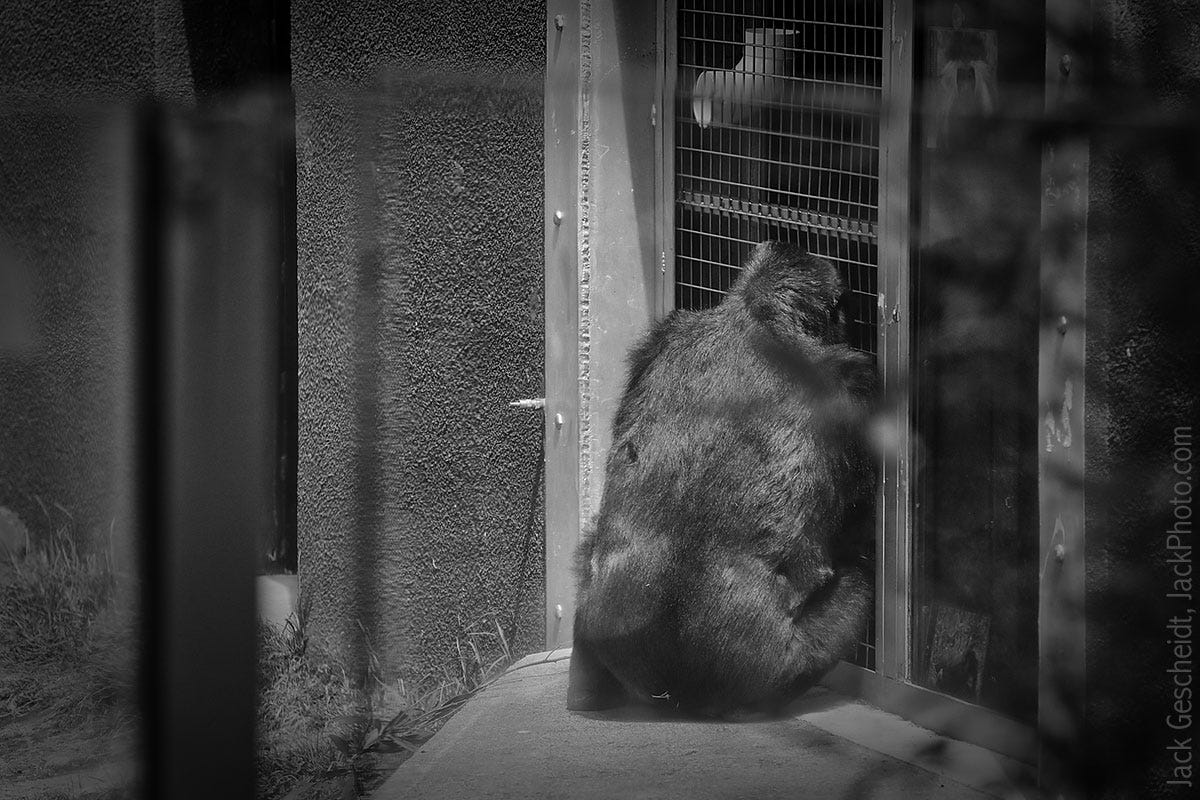Oscar the Gorilla’s Death Was Preventable. The SF Zoo’s Response? Cocktails
Eight months after Oscar’s preventable death, the San Francisco Zoo is hosting a gala to celebrate his replacement, Cecil.

It’s been revealed that Oscar Jonesy—the longtime resident silverback gorilla—had heart disease, and was anesthetized against zoo-industry recommendations.
At the August Joint Zoo Committee meeting, Ingrid Russell, the San Francisco Zoo’s Vice President of Compliance and Animal Welfare, disclosed for the first time—and now in a recent zoo press release—that Oscar had been diagnosed with heart disease.
That revelation came six months too late.
Oscar, who had lived at the San Francisco Zoo since 1981, died in February after being anesthetized for what officials described as a “routine medical procedure.”
He never woke up.
According to the Great Ape Heart Project (GAHP)—the global authority on ape cardiac care—gorillas with known or suspected heart disease should never be placed under general anesthesia unless it’s absolutely life-saving. The cardiovascular risks are too high, and modern zoos are urged to use non-invasive monitoring and awake medical training instead.
But San Francisco Zoo didn’t follow that guidance.
Oscar’s death wasn’t a freak accident. It was a preventable outcome—one that raises serious questions about veterinary oversight, leadership accountability, and whether the zoo is capable of protecting the animals in its care.
A Pattern of Preventable Tragedies
Oscar’s death joins a grim list of preventable losses. His daughter Kabibe was crushed to death by a hydraulic door in 2014. Zura, another gorilla, died in 2020 under questionable circumstances. Former staff have described unsafe working conditions, inadequate training, and outdated infrastructure that compromise both animal welfare and employee safety.
New Leadership, Old Habits
This year, the zoo announced “new leadership.” But this weekends ZooFest 2025 fundraiser—“Silverback Soirée”—shows how little has actually changed.
According to the zoo’s press release, the October gala will celebrate the arrival of 27-year-old silverback Cecil from the Louisville Zoo. Guests will enjoy an “elegant evening” featuring signature cocktails—the “Gorilla’s Kiss” and “Cecil Spritz”—and a VIP reception at the Jones Family Gorilla Preserve, where Oscar lived and died.
Partying Through the Pain
Cecil’s arrival isn’t just another transfer—it’s a window into the culture that defines the San Francisco Zoo.
Rather than reflecting on the preventable death of Oscar Jonesy, the zoo is doubling down on the same behavior that led to it: managing appearances, moving animals like inventory, and confusing public relations with progress.
By uprooting Cecil—a 27-year-old sentient, emotionally complex being—from his stable, long-term social group in Louisville, the zoo is perpetuating a system that views gorillas as pieces in a breeding puzzle, not as individuals with memory, attachment, and will.
For two decades, Cecil lived with companions he knew and trusted. Now he’s been flown across the country, separated from his family, and placed into a facility that lost its last silverback under preventable circumstances—all so he can be paired with three females in hopes of producing offspring.
This isn’t conservation. It’s captivity management dressed up as mission work.
Inside the zoo’s culture, control masquerades as care. Every decision—who breeds, who moves, who lives in which enclosure—is filtered through the lens of institutional convenience and marketing value. Reflection and accountability are seen as threats; transparency is treated like risk. Even after a gorilla dies under anesthesia, the instinct is not to pause, but to pivot—to the next press release, the next headline, the next “new chapter.”
For the people who work there, this culture erodes morale and silences dissent. For the animals who live there, it erases individuality and agency.
Cecil isn’t a fresh start. He’s another victim of a system that refuses to evolve—one that breaks bonds in the name of breeding and calls it conservation.
Until the San Francisco Zoo replaces its culture of control with one of compassion, every gorilla who enters its gates will carry the weight of Oscar’s loss—and the burden of a system that still doesn’t see them for who they are.
Honor Oscar with Accountability
If the San Francisco Zoo truly wants to honor Oscar Jonesy, it should:
Release his full necropsy and anesthesia records.
Adopt non-invasive health monitoring for all great apes.
Allow independent oversight of veterinary decisions.
Acknowledge—and change—the culture that treats animals like inventory instead of individuals.
Instead, we get cocktails and press releases.
Oscar’s death should mark the end of an era. It’s time for a new model—one that stops treating sentient beings as inventory and starts building a future rooted in care, transparency, and respect.
